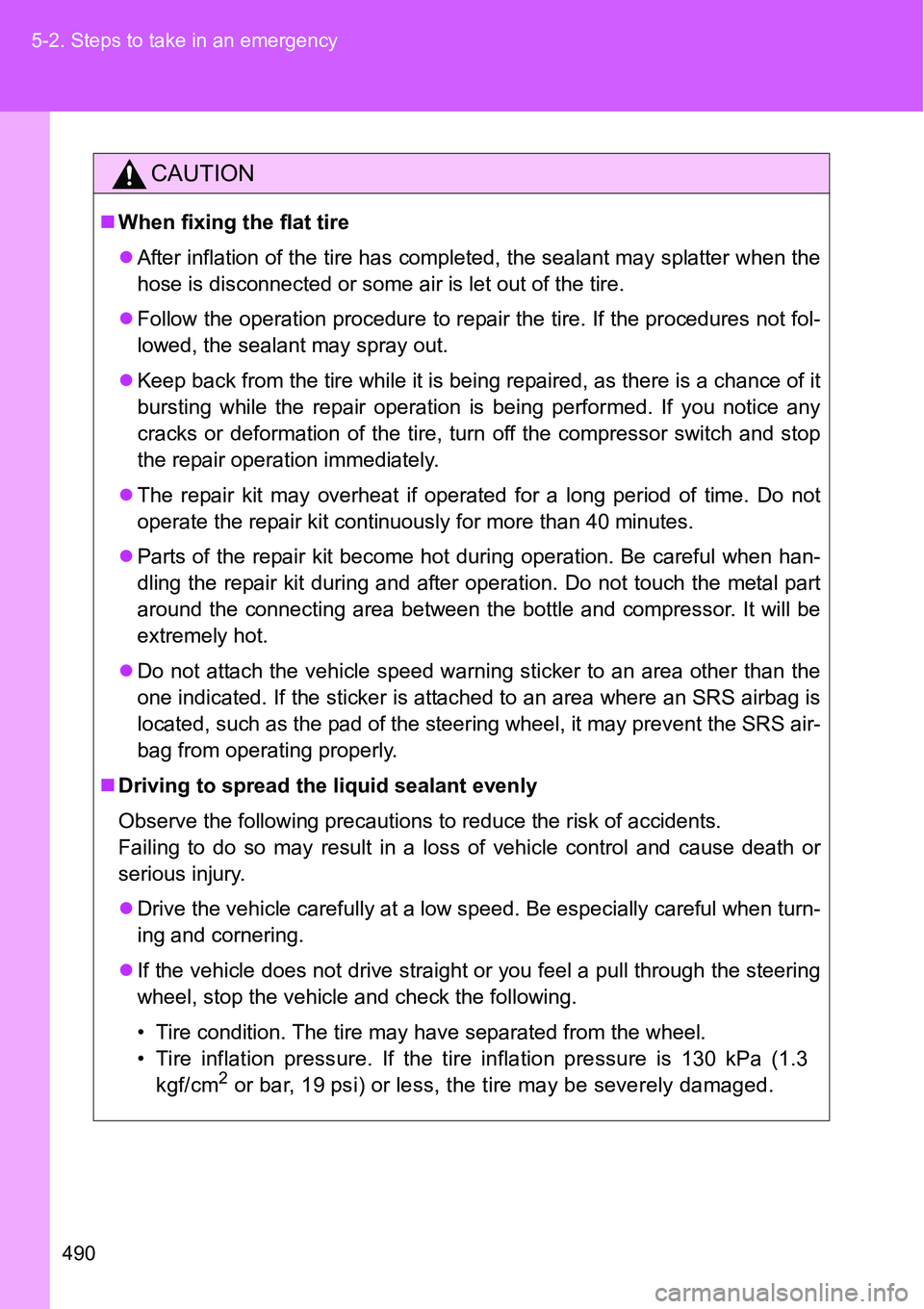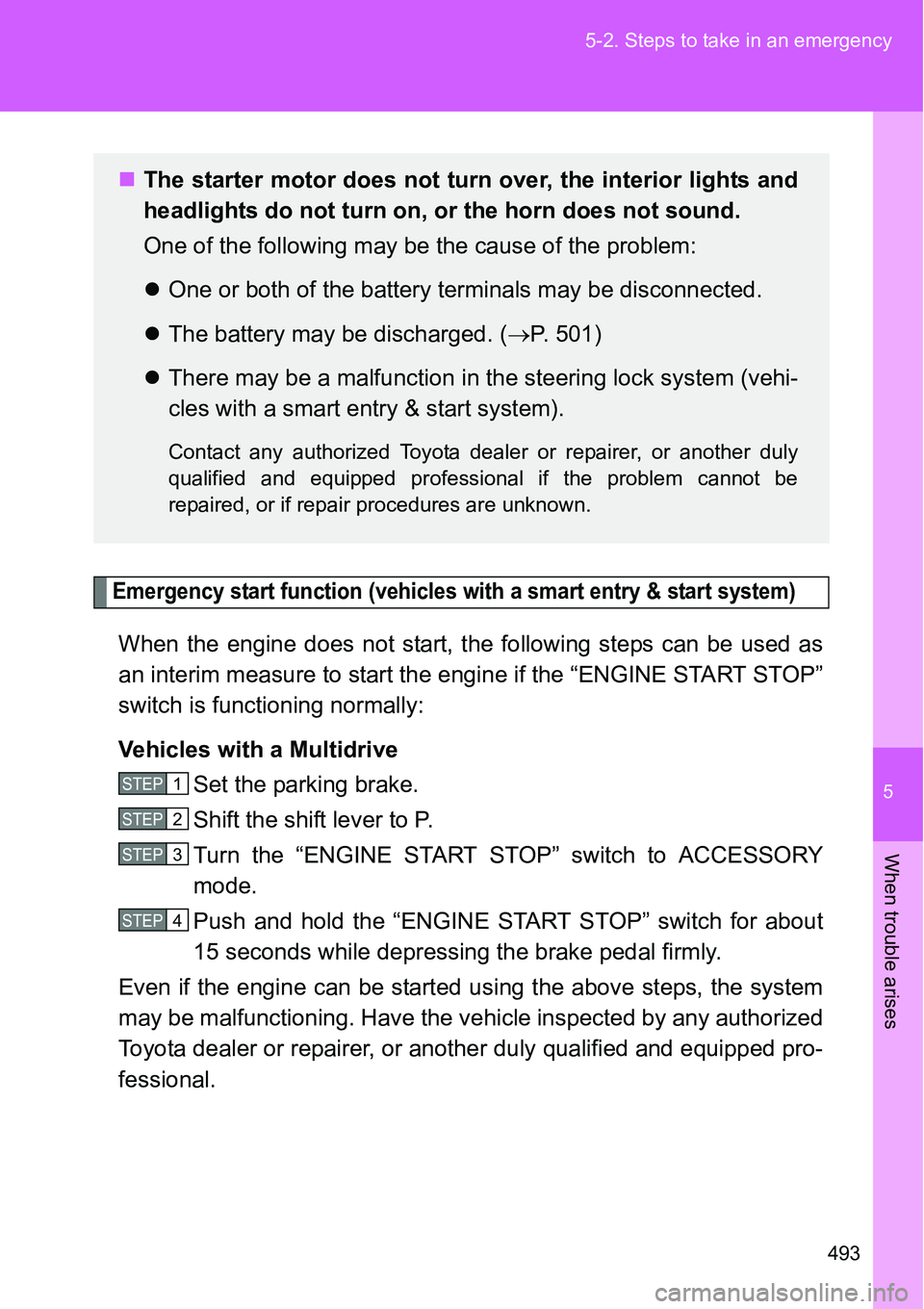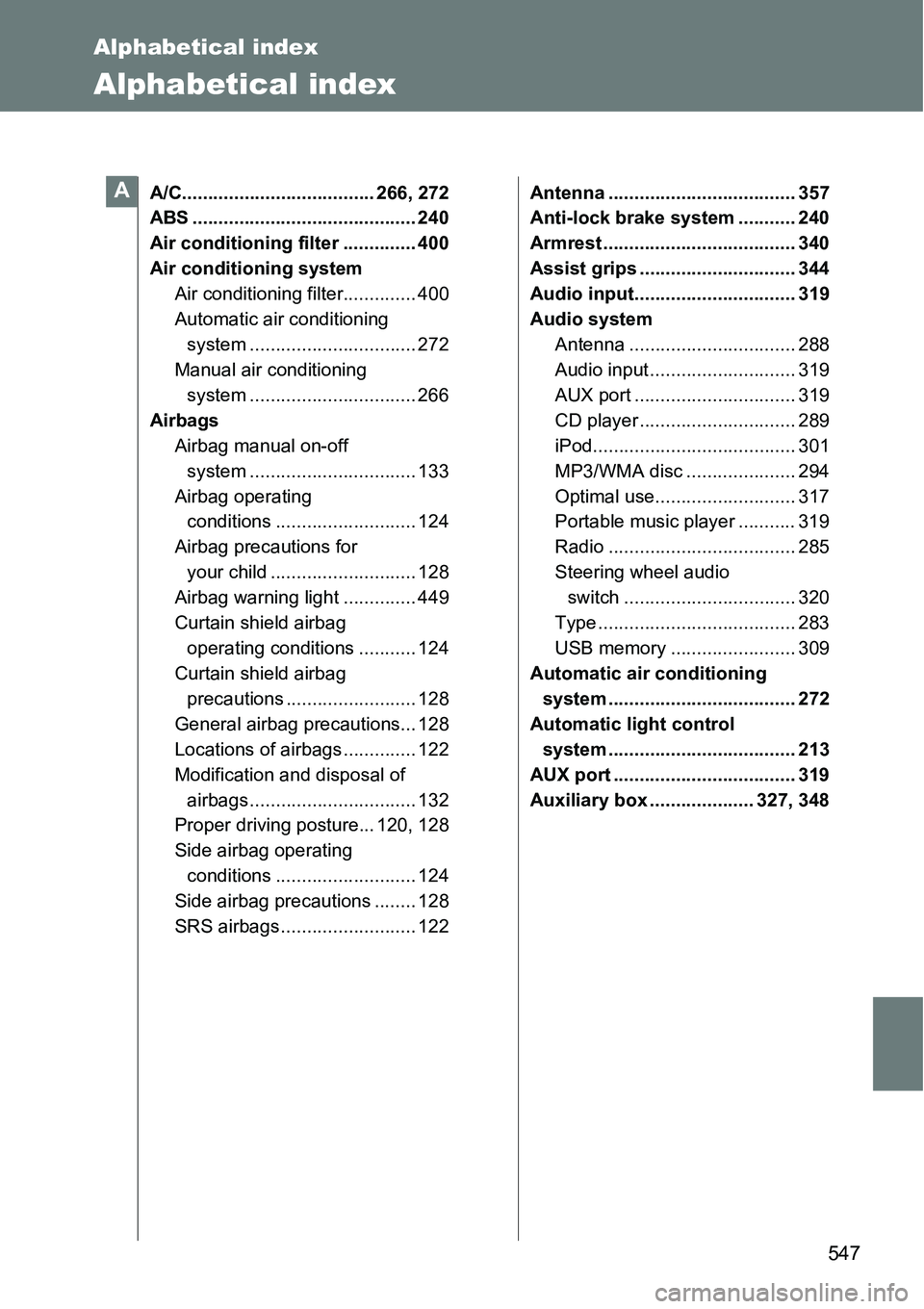Page 490 of 564

490 5-2. Steps to take in an emergency
CAUTION
When fixing the flat tire
After inflation of the tire has completed, the sealant may splatter when the
hose is disconnected or some air is let out of the tire.
Follow the operation procedure to repair the tire. If the procedures not fol-
lowed, the sealant may spray out.
Keep back from the tire while it is being repaired, as there is a chance of it
bursting while the repair operation is being performed. If you notice any
cracks or deformation of the tire, turn off the compressor switch and stop
the repair operation immediately.
The repair kit may overheat if operated for a long period of time. Do not
operate the repair kit continuously for more than 40 minutes.
Parts of the repair kit become hot during operation. Be careful when han-
dling the repair kit during and after operation. Do not touch the metal part
around the connecting area between the bottle and compressor. It will be
extremely hot.
Do not attach the vehicle speed warning sticker to an area other than the
one indicated. If the sticker is attached to an area where an SRS airbag is
located, such as the pad of the steering wheel, it may prevent the SRS air-
bag from operating properly.
Driving to spread the liquid sealant evenly
Observe the following precautions to reduce the risk of accidents.
Failing to do so may result in a loss of vehicle control and cause death or
serious injury.
Drive the vehicle carefully at a low speed. Be especially careful when turn-
ing and cornering.
If the vehicle does not drive straight or you feel a pull through the steering
wheel, stop the vehicle and check the following.
• Tire condition. The tire may have separated from the wheel.
• Tire inflation pressure. If the tire inflation pressure is 130 kPa (1.3
kgf/cm
2 or bar, 19 psi) or less, the tire may be severely damaged.
Page 493 of 564

5
493 5-2. Steps to take in an emergency
When trouble arises
Emergency start function (vehicles with a smart entry & start system)
When the engine does not start, the following steps can be used as
an interim measure to start the engine if the “ENGINE START STOP”
switch is functioning normally:
Vehicles with a Multidrive
Set the parking brake.
Shift the shift lever to P.
Turn the “ENGINE START STOP” switch to ACCESSORY
mode.
Push and hold the “ENGINE START STOP” switch for about
15 seconds while depressing the brake pedal firmly.
Even if the engine can be started using the above steps, the system
may be malfunctioning. Have the vehicle inspected by any authorized
Toyota dealer or repairer, or another duly qualified and equipped pro-
fessional.
The starter motor does not turn over, the interior lights and
headlights do not turn on, or the horn does not sound.
One of the following may be the cause of the problem:
One or both of the battery terminals may be disconnected.
The battery may be discharged. (P. 501)
There may be a malfunction in the steering lock system (vehi-
cles with a smart entry & start system).
Contact any authorized Toyota dealer or repairer, or another duly
qualified and equipped professional if the problem cannot be
repaired, or if repair procedures are unknown.
STEP1
STEP2
STEP3
STEP4
Page 519 of 564
5
519 5-2. Steps to take in an emergency
When trouble arises
CAUTION
If the engine has to be turned off while driving
Power assist for the brakes and steering wheel will be lost, making the
brake pedal harder to depress and the steering wheel heavier to turn.
Decelerate as much as possible before turning off the engine.
Vehicles without a smart entry & start system: Never attempt to remove
the key, as doing so will lock the steering wheel.
Vehicles with a smart entry &
start system: To stop the
engine, press and hold the
“ENGINE START STOP”
switch for 2 consecutive sec-
onds or more, or press it
briefly 3 times or more in suc-
cession.
Stop the vehicle in a safe place by the road.
Press and hold for 2 seconds or more,
or press briefly 3 times or more
STEP4
STEP5
Page 523 of 564
523 6-1. Specifications
6
Vehicle specifications
*1: Unladen vehicles
*2: Vehicles without Stop & Start system
*3: Vehicles with Stop & Start system
*4: Except vehicles with leather wrapped steering wheel
*5: Vehicles with leather wrapped steering wheel
Vehicle identification
Vehicle identification number
The vehicle identification number (VIN) is the legal identifier for
your vehicle. This is the primary identification number for your
Toyota. It is used in registering the ownership of your vehicle.
This number is stamped under
the right-hand front seat.
Maximum permissi-
ble axle capacityFront 900 kg (1985 lb.)
Rear 825 kg (1819 lb.)
Drawbar load 50 kg (110 lb.)
Towing capacity
with
brake800 kg (1764 lb.)
without
brake550 kg (1213 lb.)
Page 534 of 564
534 6-1. Specifications
Brakes
*1: Minimum pedal clearance when depressed with a force of 300 N (30.6 kgf,
67.4 lbf) while the engine is running
*2: Parking brake lever travel when pulled up with a force of 196 N (20 kgf, 44
lbf)
Steering
Pedal clearance*1
1NR-FE
engineLeft-hand drive vehicles
88 mm (3.46 in.) Min.
Right-hand drive vehicles
79 mm (3.11 in.) Min.
1ND-TV
engine85 mm (3.35 in.) Min.
Pedal free play 1 6 mm (0.04 0.24 in.)
Parking brake lever travel *28 11 clicks
Fluid typeSAE J1703 or FMVSS No.116 DOT 3 or
SAE J1704 or FMVSS No.116 DOT 4
Free play Less than 30 mm (1.2 in.)
Page 546 of 564
546
Abbreviation list
Abbreviation/Acronym list
ABBREVIATIONSMEANING
A/C Air Conditioning
ABS Anti-lock Brake System
ACC Accessory
CRS Child Restraint System
DPF Diesel Particulate Filter system
ECU Electronic Control Unit
ELR Emergency Locking Retractor
EPS Electric Power Steering
GVM Gross Vehicle Mass
LED Light Emitting Diode
MPAC Maximum Permissible Axle Capacity
PEN Polyethylene Naphthalate
PET Polyethylene Terephthalate
PTC Positive Temperature Coefficient
SRS Supplemental Restraint System
TRC Traction Control
VIN Vehicle Identification Number
VSC Vehicle Stability Control
VSC+ Vehicle Stability Control+
Page 547 of 564

547
Alphabetical index
Alphabetical index
A/C..................................... 266, 272
ABS ........................................... 240
Air conditioning filter .............. 400
Air conditioning system
Air conditioning filter.............. 400
Automatic air conditioning
system ................................ 272
Manual air conditioning
system ................................ 266
Airbags
Airbag manual on-off
system ................................ 133
Airbag operating
conditions ........................... 124
Airbag precautions for
your child ............................ 128
Airbag warning light .............. 449
Curtain shield airbag
operating conditions ........... 124
Curtain shield airbag
precautions ......................... 128
General airbag precautions... 128
Locations of airbags .............. 122
Modification and disposal of
airbags ................................ 132
Proper driving posture... 120, 128
Side airbag operating
conditions ........................... 124
Side airbag precautions ........ 128
SRS airbags .......................... 122Antenna .................................... 357
Anti-lock brake system ........... 240
Armrest ..................................... 340
Assist grips .............................. 344
Audio input............................... 319
Audio system
Antenna ................................ 288
Audio input ............................ 319
AUX port ............................... 319
CD player .............................. 289
iPod....................................... 301
MP3/WMA disc ..................... 294
Optimal use........................... 317
Portable music player ........... 319
Radio .................................... 285
Steering wheel audio
switch ................................. 320
Type ...................................... 283
USB memory ........................ 309
Automatic air conditioning
system .................................... 272
Automatic light control
system .................................... 213
AUX port ................................... 319
Auxiliary box .................... 327, 348A
Page 550 of 564

550 Alphabetical index
Daytime running light
system .................................... 216
Deck board ............................... 347
Defogger
Rear window ......................... 281
Side mirror ............................ 281
Dimension ................................ 522
Display
Trip information ..................... 210
Do-it-yourself maintenance .... 364
Doors
Door lock ..................... 33, 57, 66
Door windows ......................... 98
Double locking system .......... 115
Side mirrors............................. 96
DPF
Diesel Particulate Filter
system ................................ 246
Warning light ......................... 450
Driver's seat belt reminder
light ......................................... 450
Driving
Break-in tips .......................... 162
Correct posture ..................... 120
Procedures............................ 158
Winter driving tips ................. 250
Dual-level deck board.............. 347Electric power steering ........... 240
Electronic key
If the electronic key does
not operate properly ........... 497
Replacing the battery ............ 403
Emergency flashers
Switch ................................... 436
Emergency, in case of
If the electronic key does not
operate properly ................. 497
If the engine will not start ...... 492
If the shift lever cannot be
shifted from P ..................... 495
If the vehicle has a
discharged battery .............. 501
If the warning buzzer
sounds ................................ 447
If the warning light
turns on .............................. 447
If you have a flat tire .... 462, 475
If you lose your keys ............. 496
If you run out of fuel and
the engine stalls ................. 514
If you think something is
wrong.................................. 445
If your vehicle becomes
stuck ................................... 516
If your vehicle has to be
stopped in an
emergency.......................... 518
If your vehicle needs to be
towed .................................. 437
If your vehicle overheats ....... 509DE